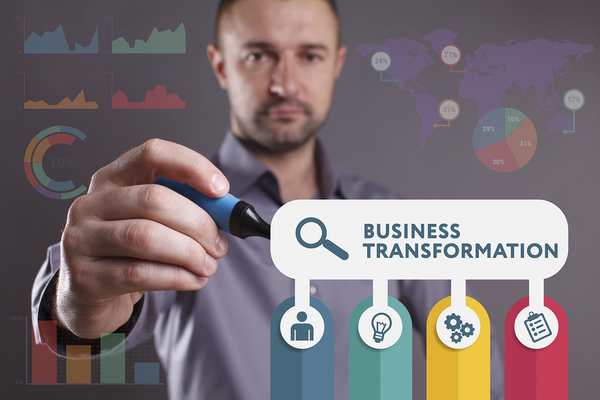
The world is in the midst of an industrial revolution, driven by disruptive forces that are changing the way companies operate. These digital disruptions are changing the way companies think about their business models, business processes, and how work is done.
Understanding what digital transformation means for your organization, customers, suppliers, and employers is essential to being able to leverage these new technologies to the greatest advantage. To take these significant steps involves knowing how ready the enterprise, its leaders, and its employees are for the changes to come.
The fundamental question every organization must ask today when it comes to digital transformation is: “Is your organization ready?”
What Is Digital Transformation?
At its core, digital transformation is the ability of companies to adapt and respond to new technologies that are affecting their industries and their customers. Yet while the technologies that are the cause of digital transformation are the drivers of these transformations, it is the ability of an enterprise to prepare and evolve its capabilities, systems, people, and approach to business that will set it apart from its competitors.
Digital transformation has wide-ranging effects on the enterprise, forcing change in how leaders think about the products and services they offer, how those products are delivered, their markets, and operations. Disruption is hitting all industries to some degree or another, fueled by transformations in the way customers and consumers want to interact with products they purchase and brands to which they are loyal.
Challenges and Opportunities
In 2018, digital transformation is ubiquitous. How can enterprises determine the right path with myriad options and potentialities at play? Understanding some of the trends facing industries this year is a good place to start. Here are some of the top issues, challenges, and considerations for companies looking to embark on digital transformation:
- Blockchain. Blockchain, the technology behind Bitcoin and other cryptocurrencies, enables secure transactions that provide a traceable and transparent record for all parties involved. Blockchain has already established a foothold among financial institutions; it has utility across many different industries. It is likely to become the norm for transactional technologies in 2018 or soon thereafter.
- Artificial Intelligence. AI already is in place in many industrial and consumer areas. Think of the prevalence of Apple’s Siri and Amazon’s Alexa assistants, which use artificial intelligence tools to solve problems and perform basic tasks. AI is also gaining traction in industrial settings, improving customer service, marketing, and analytics. AI tools provide easy ways to automate processes and communicate with customers. As AI becomes more the norm, companies will identify ways to streamline operations and reduce costs.
- The Internet of Things. IoT will continue to expand, creating more connected devices equipped with sensors, computers, and wireless functionality. These devices will generate more data that can, in tandem with data analytics, provide deep insights, often in real time.
- Edge Computing. The sheer volume of data available today means that transmitting it all to the cloud may become impractical. Edge computing is one way for companies to collect and analyze data at the source, enabling connected devices to share, use, and analyze data locally.
- 5G. With more data generated and expectations of customers and consumers to access and use data faster, 5G will likely make more strides in 2018. While companies are gradually looking to 5G technologies, there is little specifically to consider at this point. However, companies will need to recognize that mobile users will always want more speed.
- 3-D Visualization. Training, repairs, presentations, and R&D are all seeing the benefit of 3-D visualization tools, which have eclipsed virtual reality in many sectors as the go-to technology for rendering and virtualization needs.
- Failing Fast. Companies are having to make rapid decisions about where to go with technological commitments. That means many will make the wrong bet, despite good information. The evolution of existing technologies and the introduction of new ones is simply happening too fast. What nimble and resilient companies are doing in response is learning how to fail fast. Visualization and rapid prototyping will permit companies to roll out new ideas quickly, test them, and make better decisions faster. Companies that know whether to adjust or abandon will be better able to remain responsive and competitive.

Building Resilience
Companies that want to succeed today need to establish a resilient culture that is ready to respond to risks, assess their viability, and see both the threats and the opportunities that those risks can pose.
Companies need to have clear policies and procedures for assessing and implementing new technologies. By responding quickly to the opportunities, and learning how to identify pluses and minuses, employees at all levels of an enterprise can become better equipped to handle difficult situations. Growing from those challenges and risks means a workforce that is more adaptable and nimble when the inevitable next risk emerges.
Enterprise organizations need to have tools available that allow for silos to be knocked over, enabling more integration and collaboration across business units and locations. With so much data moving so quickly, employees need to be able to access information across departments and systems, work together, and explore synergies.
A company culture that does not embrace agility and flexibility will instead remain rigid, unable to pivot when it is necessary, exposing the organization to even more risk and threatening loss of market share to competitors, both those traditionally in a sector and disruptive newcomers.
The Importance of the Cloud
To remain flexible, nimble, and responsive, companies need access to powerful cloud-based services. With the cloud, companies can develop and host applications and data across systems. Companies can scale quickly as needs or markets emerge. Reporting can provide real-time insights that drive better decision-making.
While cloud technology is, in itself, a digital transformation, it also holds the keys to allow companies to gain insights and access and store information. It acts as the essential tool to help companies determine which steps to take in order to remain competitive and seize markets and market share.
Cloud-based services create the transformative opportunities for companies that are prepared. Migrating to the cloud increases efficiency, lowers costs, results in better performance, and improves security.
To be successful, companies need to assess their readiness to move to the cloud. Cloud migrations are complex, critical projects that have significant payoffs. Is your company ready for a cloud migration? Consider the following questions.
Will my company benefit from a move to the cloud?
This step involves answering questions about your organization’s IT infrastructure costs and whether cloud computing will reduce those costs. Does your IT usage fluctuate or is it constant? Is there a need for additional IT functionality or applications and can the organization support the capital expenditures necessary?
Next, you need to assess your IT department’s ability to maintain and secure existing IT infrastructure. Does the department maximize the efficiency of that infrastructure?
These calculations also need to factor in whether there are regulatory requirements for where data can or cannot be stored. It also needs to consider whether increased accessibility by having data and applications in the cloud will improve performance.
What is the organizational readiness for the cloud?
Your company needs a cloud adoption strategy to help it determine what would go to the cloud, when, and why. This strategy needs to consider how quickly the organization’s data and processes need to move to the cloud and what the costs will be to do so.
Your organization needs to be prepared to migrate sensitive data and have the team in place to do so. Each of your systems and applications needs to be assessed related to its importance to the business. Customizations need to be evaluated to determine whether they are still necessary for the business.
Security is another important factor in making a cloud determination. Understanding how assets are secured today and how they would be secured in the cloud is one key factor. Security controls should be documented, tested, and verified.
When making a cloud migration, security is paramount. That means determining what data will be encrypted and what access points there are across devices, locations, and operating systems. Policies will need to be developed to determine access levels for data and applications.
A comprehensive security assessment should include an evaluation of physical locations, remote connections, and staff awareness. Potential vulnerabilities should be identified, prioritized, and addressed.
What personnel needs exist?
Every cloud migration project requires a strong team that has the support of senior management and is empowered to make decisions. The team may include internal staff, external consultants, and partners that have the full support of leadership.
Moving to the cloud will mean changes to processes and everyday work. Training needs to be developed and deployed to ensure that companies buy into the changes and are able to continue to work effectively under the new plan. Staff needs to understand the technologies, security needs, and new functionality.
How will cloud providers be evaluated?
Cloud solutions vary greatly. There need to be clear evaluative tools in place to help companies determine what is needed from a cloud provider, what costs are acceptable, what the full costs are (including those from transferring data), and what the physical location of servers will be.
You also need to determine the reliability and reputation of your cloud providers. Do they offer a reliability guarantee? What are the implications for your company if reliability is not met? Is there a business continuity plan in place to ensure that your company and cloud provider remedy issues quickly?
Finally, you need to know about the performance capabilities of your provider and be sure that as your needs change, your provider can accommodate them.
A Digital Transformation Partner
At Denovo, we help companies by providing functional, platform, infrastructure, and disaster recovery managed services. Our tools provide the foundation that lets companies drive transformational change. To learn more about how Denovo can help guide your company’s digital transformation, schedule a free consultation today.

Share this guide to digital transformation and the profound impact of cloud computing @DenovoCloud #digitaltransformation.
